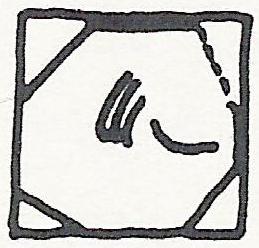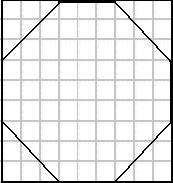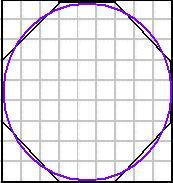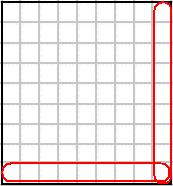Do a little searching on the Internet, and you’ll find the ancient Egyptian value for given as 3.16. Do a little more searching and you might get the more exact answer of
.
Where did these numbers come from? How did Egyptians discover the procedure for working with circles in the first place? And finally, did the Egyptians really know anything about , or was this a later extrapolation?
The document that gets used to find is the Rhind Mathematical Papyrus (1650 BC); sometimes it’s known as the A’h-mosè Papyrus depending on if you’re naming it after the person who purchased it or the person who wrote it. I personally prefer the actual title given by the author,
Directions for Attaining Knowledge of All Dark Things
but to be consistent with mathematical historians I’ll call it the RMP, for Rhind Mathematical Papyrus.
The RMP itself is divided into 87 problems. (The last three are enigmatic and mangled and may not be problems at all, so sometimes the count is given as 84.) The problem we’re looking at here is #50, the second one on this page.

The translation goes roughly
Example of finding the area of a round field with a diameter of 9 khet. What is its area?
Take away 1/9 of its diameter, namely 1. The remainder is 8.
Multiply 8 times, making 64. Therefore the area is 64 setjat.
(1 khet = about 52.3 meters = about 57.2 yards)
If you like, you can try to work out this point how comes about. You need to compare the formula the Egyptians get with the circle area formula of
. Come back when you’re ready.
Given a diameter of 2r, 1/9 of it is
So “cut off” 1/9 of the diameter we subtract from the original diameter
And we’re left with
Turning that length into the side of a square, the area is the expression squared
With simplification it becomes
Voila, by matching this formula with , out comes a value of 256/81 for
.
That’s lovely, but how did the Egyptians know that such a strange procedure would get the right area? It’s possible they came up with it using raw experimentation, but there’s a hint one page back in the manuscript of what the Egyptians were really up to.

This is from problem 48, which is a touch enigmatic. There’s no stated goal, just the calculation, which gives the area of the square as 81, and the area of the circle (octagon?) on the inside as 64.
Whether the figure is an octagon or a circle is up for some debate. Richard Gillings argues it is an octagon, because the other circles that show up in the manuscript (like for #50) are obviously drawn as circles, but it’s possible the author affected a different stroke because the figure is inscribed within a square. I’m going with circle, because an area of 64 for the octagon isn’t just approximate, it’s wrong.
(The argument that follows is also courtesy Richard Gillings.)

Even using the simplest of methods (just count!) it isn’t hard to find an area of 63 for the octagon. Noting that a circle isn’t too far off from the octagon

and that the 18 missing squares can be arranged (with one overlapping) like so

It’s quite possible to imagine the area of the circle as the approximate area of the 8 by 8 square remaining.
The question I want to raise about all this is: did the Egyptians really know anything about at all? Is it fair to compare what they did to Newton’s 15 digits, when the presumed value is extrapolated from a single procedure in the RMP?
In the Indian text Sulba Sutras there is a different value for the area procedure and the circumference procedure. I argue the Egyptian achievement is comparable — it’s a procedure, not actual knowledge of the ratio — and the caveat needs to be noted in histories of the number.
Filed under: History, Mathematics |


Nice post. And so appropriate with pi-day coming up soon.
yo pi day is a rip off theres no pi on sale
This article was a lot of help on my school Geometry project. Thanks!
ya same here
not really geometry but gifted but still c:
it dosent give me any thing
I’m not sure what you’re referring to, but if you mean the link to the picture of the entire section of the RMP, there is a Unicode issue that can cause some browsers a headache. Go to the original Wikipedia article and click on the picture from there and you should be fine.
[…] Babylonian Value for Pi Posted on December 3, 2008 by Jason Dyer I have written about the ancient Egyptian value for before, concluding that while the Egyptians had a procedure for finding the area of a […]
It is really helpful and it can help some people in the future.
it doesnt say which peple discovered pi.
I am presuming you had some school assignment to the effect. The problem with the question is there are multiple arguable answers.
I don’t want to do your assignment for you, but you should read about the Babylonian value of pi (just check the link a couple comments above) and also read about what Archimedes did with pi.
The Babs got their knowledge from Egypt
And the Egyptians got it from Mars.
Thanks for posting. Very helpful for my Development of Math Thought class.
what are all the digests after the decimal point?
Maybe the decimal point had an issue digesting. XD
256/81 = 3.160493827… where the digits then repeat
5000 years before, common people had obviously learn only to add, subtract, multiply and divide without the knowledge of decimal system.
The example is attempting to avoid fractions for simpletons. Replace the word ‘khet’ with ‘unit’ to simplify. 1/9th of 9 is 1. Now take away 1 from 9. Remainder is 8. Multiply 8 with 8 yields 64. 8 is not a constant for other example but for this the example to obtain a round number result.
The mathematical statement is “square of 8/9th of the length of the diameter is the area of the round object”
8/9 = 0.8888888…9
[…] (Image courtesy of The Number Warrior) […]
[…] to mathematician Jason Dyer, the Egyptian translation reveals that the Rhind is instructive: “Example of finding the area of a round field with a […]
I don’t know a ton about math and am not great at it either. But i like philosophy and I think this is a philosophical question rather than a mathematical one.
There are some who say pi was invented by Archamedes. In some of the research I looked at pi apparently was used by different cultures for area. Some of those numbers for pi calculations are different but the area is the correct. The Greeks, Hebrews, Egyptians, Babylonians, Indian and Persians all have varied factors for pi but very accurate ratios for area. Maybe this is by accident maybe not. All of these cultures used light and shadows to map time and measurements. Maybe having the answer based on earthen geometrics is a trail back to pi versus a formula first theory(chicken or egg theory).
Here’s my best guess:
I would say that pi is not so much a numeric value for every area but rather a numeric ratio for a given area. Can you have pi without an area first? Does not the area beg an equation rather than the equation an area.
Feedback?
[…] to mathematician Jason Dyer, the Egyptian translation reveals that the Rhind is instructive: “Example of finding the area of a round field with a […]
i dont really know what im doing on this site i just know my teacher sent me hear on a scavenger hut
same
same
hi jaydon
hi
i honestly couldn’t care less about anything this site has to say
i don’t care about this at all
hi jaydon
fr get ypour mams digits dogs cat fr
don’t know a ton about math and am not great at it either. But i like philosophy and I think this is a philosophical question rather than a mathematical one.
There are some who say pi was invented by Archamedes. In some of the research I looked at pi apparently was used by different cultures for area. Some of those numbers for pi calculations are different but the area is the correct. The Greeks, Hebrews, Egyptians, Babylonians, Indian and Persians all have varied factors for pi but very accurate ratios for area. Maybe this is by accident maybe not. All of these cultures used light and shadows to map time and measurements. Maybe having the answer based on earthen geometrics is a trail back to pi versus a formula first theory(chicken or egg theory).
Here’s my best guess:
I would say that pi is not so much a numeric value for every area but rather a numeric ratio for a given area. Can you have pi without an area first? Does not the area beg an equation rather than the equation an area.
I couldn’t agree more
ert your are one smart dude nicely said
Bible”Bible” jews jews are cool smart app buy nhow wig
You can consult my 2 papers on the Egyptian method of the squaring the circle:
Click to access JMESTN42351779.pdf
Click to access Full-Paper-AHMES%E2%80%99-METHOD-TO-SQUARING-THE-CIRCLE.pdf
Mietek
By 3,500 BC the Egyptians were already using the 22/7 approximation for pi in their Pyramids.. here’s the proof.. http://www.math-math.com/2017/04/mysterious-pyramid-mathematics.html
The ACPO team produced Si 28 spheres with diameters of 9.375 Centimeters. The specific gravity of Si is 2.3296 gr cc. The Weight of the Si 28 sphere is 1000 grams. Therefore, the volume of the sphere is 429.26 cc. This gives the value of Pi at 3.1258 (3.125763).This is pretty close to Babylonian value of Pi. Will the Perfect Sphere of Si-28 give a Perfect Value of Pi?
[…] she got a value of just above three. This places her answer between the Biblical value of 3 and the ancient Egyptian value of 256/81. The problem was quite frustrating for the younger version of Occupy Math’s editor […]
Very interesting, Thank you. Visit http://www.proofpi.com for more about the value of Pi.
[…] an ancient Egyptian method that comes a little closer to being a formula, which I find described here and here, taken from the Rhind papyrus. (We had answered a question about it here.) As a formula, […]
Given the penchant in ancient Egypt for progressive doubling (as employed in multiplication, for example), whenever the ratio 8/9 is observed one must imagine the Egyptian view of that ratio when each numeral is doubled or “1618,” likely an intended reference to a number with a sacred connotation, i.e. 1.618. It is also useful to be aware that the measurement for a Khet (52.3 meters) is the same number as the Egyptian Royal Cubit which according to Petrie’s measurements of the Kings Chamber in the Great Pyramid is .52395 of a meter and according to R.A. Schwaller de Lubicz was actually 1/6 of Pi or .52359.
Reblogged this on Die Goldene Landschaft.
[…] On the Ancient Egyptian Value for Pi […]
[…] On the Ancient Egyptian Value for PiThe History of Zero | YaleGlobal Onlinehttps://en.wikipedia.org/wiki/Moscow_Mathematical_Papyrus#/media/File:Moskou-papyrus.jpgTarihöncesi, Babil ve Mısır Matematiği […]
This problem was in a child’s textbook. You left that part out, which is incredibly important. If 2000 years from now, someone picked up 5th grader’s math homework & assumed this was an accurate representation of the state of mathematics for 2021, it wouldn’t be true. If this was in a child’s textbook, obviously the actual mathematicians had extremely more advanced formulas than this. This is simple baby math, not “good for an ancient civilization without calculators”. Almost insulting. Going through the rest of the problems in the papyri, you’d realize it instantly. Very similar to the word problems we did as kids “if I gave you 3 whole pizzas & took away 4 slices” type of problems.
Ancient Egyptians were notoriously secretive with their superior knowledge, quoted by Aristotle, who was upset the Egyptian priests wouldn’t reveal more of their secrets.
If anything, I think Egyptians were far more advanced than we even know & our society as a whole is less educated than the average Egyptian. Who knows.